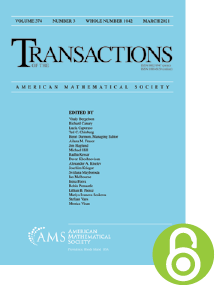Derivation alternator rings with idempotent
HTML articles powered by AMS MathViewer
- by Irvin R. Hentzel and Harry F. Smith PDF
- Trans. Amer. Math. Soc. 258 (1980), 245-256 Request permission
Abstract:
A nonassociative ring is called a derivation alternator ring if it satisfies the identities $(yz, x, x) = y(z, x, x) + (y, x, x)z, (x, x, yz) = y(x, x, z) + (x, x, y)z$ and $(x, x, x) = 0$. Let R be a prime derivation alternator ring with idempotent $e \ne 1$ and characteristic $\ne 2$. If R is without nonzero nil ideals of index 2, then R is alternative.References
- A. A. Albert, Power-associative rings, Trans. Amer. Math. Soc. 64 (1948), 552–593. MR 27750, DOI 10.1090/S0002-9947-1948-0027750-7
- Erwin Kleinfeld, Generalization of alternative rings. I, II, J. Algebra 18 (1971), 304-325; ibid. 18 (1971), 326–339. MR 0274545, DOI 10.1016/0021-8693(71)90063-9
- Erwin Kleinfeld, Generalization of alternative rings. I, II, J. Algebra 18 (1971), 304-325; ibid. 18 (1971), 326–339. MR 0274545, DOI 10.1016/0021-8693(71)90063-9
- Michael Rich, Rings with idempotents in their nuclei, Trans. Amer. Math. Soc. 208 (1975), 81–90. MR 371972, DOI 10.1090/S0002-9947-1975-0371972-9
Additional Information
- © Copyright 1980 American Mathematical Society
- Journal: Trans. Amer. Math. Soc. 258 (1980), 245-256
- MSC: Primary 17A30; Secondary 17D05
- DOI: https://doi.org/10.1090/S0002-9947-1980-0554331-7
- MathSciNet review: 554331


